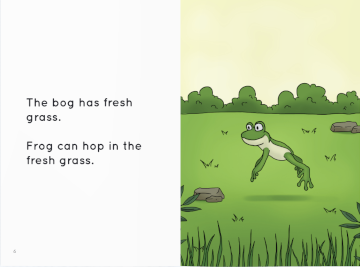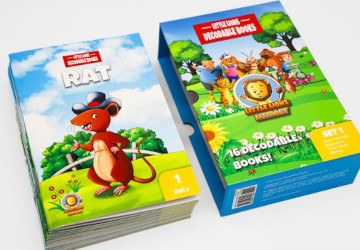The Little Lions decodable books can serve as readers alongside most phonics-based reading programs. These readers were produced by the publisher of the Pride Reading Program, which is based on Orton-Gillingham methodology. The readers are not limited to use with that program but will work best with any program based on Orton-Gillingham methodology.
The 48 readers can be purchased in sets of 16 (each set comes in a heavy-duty slipcase) or as a bundle of the three sets. At 32 pages each, these readers are longer than some other beginning readers. For each two-page spread, the right-hand page is a full-color illustration featuring talking animals, while text is printed on the left-hand page in a sans-serif font.
Each reader begins with brief instructions, followed by charts showing new phonograms and high-frequency sight words included in the stories. Children should practice reading these before tackling the story.
The last page of each book presents comprehension questions and extension activities, though some of the comprehension questions go beyond simple understanding. For instance, two questions in the twelfth reader ask, “What questions do you have after reading this story?” and “If you could change one part of the story, what would you change? Why?” The two extension activities for each reader usually involve drawing and writing four or five words from the story that contain particular phonograms.
 Set 1 works on words with short vowels, digraphs, blends, and the “Floss Rule.” (The Floss Rule helps children remember when to use a double consonant at the end of a word.) Set 2 teaches words with long vowels, two syllables, and “glued” sounds, such as in “all” where the letter a makes a sound more like short o and other instances where the vowel sound changes depending on the following letter(s). Set 3 has students read words with long i and long e patterns, vowel team syllables, r-controlled vowels, closed syllable exceptions, and suffixes.
Set 1 works on words with short vowels, digraphs, blends, and the “Floss Rule.” (The Floss Rule helps children remember when to use a double consonant at the end of a word.) Set 2 teaches words with long vowels, two syllables, and “glued” sounds, such as in “all” where the letter a makes a sound more like short o and other instances where the vowel sound changes depending on the following letter(s). Set 3 has students read words with long i and long e patterns, vowel team syllables, r-controlled vowels, closed syllable exceptions, and suffixes.
These readers give children plenty of practice as they learn new phonetic concepts, and they support phonics with high-frequency sight words that allow for more natural sentences and stories.
Little Lions Literacy is also working on a set of Alphabet Books to help children learn the letters and their sounds.









